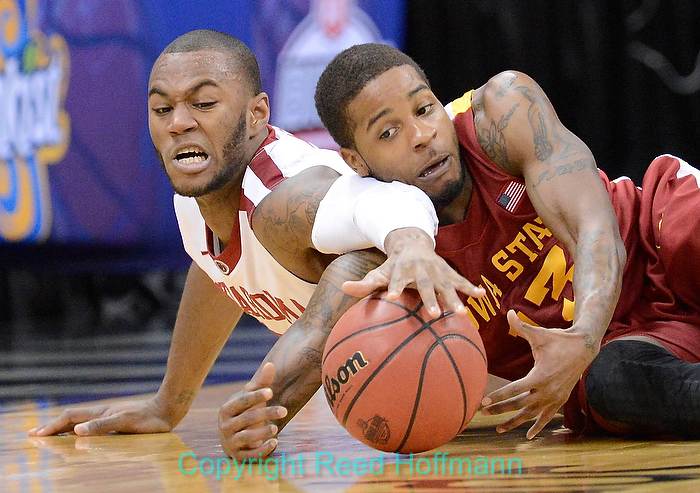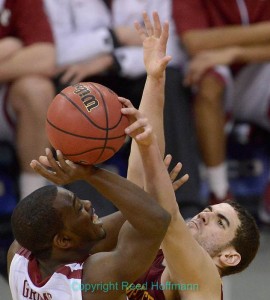Last week we had the Big 12 tournament here in Kansas City, and I managed to cover five of the games. I’ve been shooting basketball since I started in photography 40 years ago, and it’s always been my favorite sport to shoot. You can cover the entire court with two cameras and two lenses, meaning more opportunities to make pictures. Thanks to the shot clock, the players can’t stall. And you shoot from courtside with just ten players and at most three officials, so you’re not blocked as often as in sports like football. But like many sports, the fast action and lack of good light (indoors) makes for a number of challenges.
A few years ago I was at a workshop where one person asked a Sports Illustrated photographer what gear they need to shoot sports. His answer was simple, “Buy the most expensive cameras and lenses out there.” Unfortunately, that’s true. You can shoot sports with less expensive gear, especially if it’s outdoors in the daytime. But the old adage, “you get what you pay for” is particularly true of sports photography. The reasons boil down to these: reach, aperture and shutter speed, frame rate, autofocus performance and image quality. That combination doesn’t come cheap. First I’m going to talk about the basic gear needed to shoot big sports events like this, then I’ll talk about what I did at the tournament.
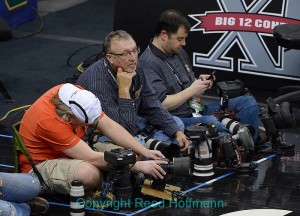
Ah, the thrill of sports! A few of my friends waiting for the action to resume during a time-out. Photo copyright Reed Hoffmann.
At most college games, credentialed photographers are allowed at each end, to one side of the basket (the other side is for the cheerleaders). If you’re lucky you have a 2-ft.-wide spot just back from the court. If not, you’re in a position behind that first row of photographers, kneeling or sitting on a small box. Being in that first row means you sit on the floor. You quickly learn to bring a floor chair to save your back.
Because you’re indoors shooting fast action, you need wide aperture (“fast”) lenses. The two favorites are the 300mm f/2.8 for action at the far end and a 70-200mm f/2.8 for the near end. Most photographers also have a wide-angle zoom (my preference is the 24-70mm f/2.8).
Shutter speeds of 1/1000 or faster are necessary to stop the action, so you need cameras (at least two) that can get good quality at ISO 3200 and above. With the large-chip (FX) Nikon cameras I use (D4, D3 and D700), I mainly shoot from 4000 to 8000 ISO.
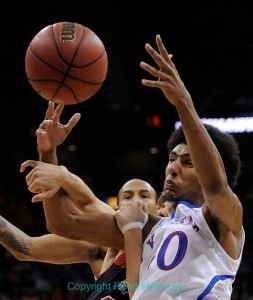
Action under the basket with the 70-200mm lens. Nikon D3 set to white balance of PRESET0 and ISO of 4000, shutter speed of 1/1600 at f/3.5, with exposure compensation at 0.0, 70-200mm f/2.8 lens, Photo copyright Reed Hoffmann.
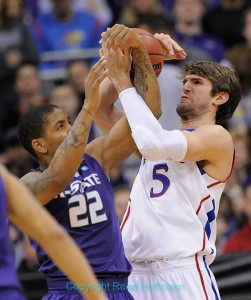
Shooting the far end with the 300mm lens and a 1.4 teleconverter. Nikon D700 set to white balance of PRESET0 and ISO of 4000, shutter speed of 1/1000 at f/4, 420mm f/4 lens. Photo copyright Reed Hoffmann.
Sports photography is all about anticipation. The best sports shooters I know don’t simply push the shutter and let the camera fire, hoping for a good picture. They try to anticipate when the action will occur, and press the shutter button just before then. If you see the action in your viewfinder and then shoot, you won’t get it. Having said that, they do shoot bursts. When something happens, you’ll generally hear the people around you firing 3-4 frames. They press for the shot they hope to get, and let a few more frames run just in case something else happens. And they do blast away when something unexpected happens, like a floor scramble for the ball. So a camera with a fast frame rate is important. Most sports photographers want cameras that are capable of 8-10 frames per second.
Since the action is constant, fast and erratic, you need the best autofocus systems made. That’s one of the things you get when you buy a more expensive camera – a faster, more powerful autofocus system. An entry-level SLR is fine for taking pictures of kids at the playground, but when you get to high-action sports, those cameras simply can’t keep up. And “fast,” or wide aperture lenses, allow more light in, letting the cameras take advantage of those fast AF systems.
This is why I always tell people that sports is the most expensive kind of photography they can get into. Landscape, portrait, close-up, or weddings can all be done well for a reasonable investment in gear. But not sports. It requires big bucks. Luckily, over the years I’ve been able to collect that gear.
As with most shoots these days, when I was preparing to go to the Big 12 I thought about what I could do that might be different. That came down to position and equipment.
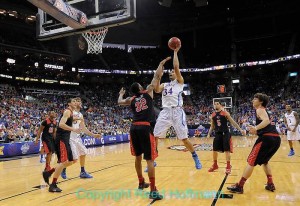
On my knees with the 24-70 gives a view of the action that few people will see. Nikon D3 set to white balance of PRESET0 and ISO of 4000, shutter speed of 1/1000 at f/4, 24-70mm f/2.8 lens. Photo copyright Reed Hoffmann.
I knew I’d be able to shoot from one of those areas to the side of the basket. We always do that. So I thought I might take one of the back positions and try shooting from my knees. That would give me two advantages. One, being on my knees instead of my butt gave me better ability to move. It also allowed me to shoot from a higher angle, looking more “into” the action than up at it, what we usually refer to as “elbows and armpits.” I also planned to use my wide-angle from that higher position, which would make the resulting photos look more like those shot from “remotes.” A remote is a camera that’s triggered by either a cable or a radio receiver, and are often mounted on or around the goal, from low to high.
As far as my gear, that really came down to what lenses and how I’d use them. I already planned on using the 24-70mm to shoot from my knees at courtside. But instead of the usual 300mm f/2.8, I wanted to shoot tighter, meaning more lens. In the past I’ve sometimes taken the 400mm f/2.8 for basketball, but it’s a very large, heavy lens. And my back would be hurting by halftime (remember, you’re sitting, and having to pick it up, put it down, pick it up…). And since our high-end cameras now let us shoot at astronomical ISO’s, I decided to use the 300mm, but bring along a pair of converters.
Teleconverters mount between the lens and the camera body to “convert” the lens you’re using into a longer lens (“tele”). The challenge is finding ones that have little or no impact on image quality. That’s harder done than said. Nikon makes three, they’re expensive and designed to only be used on the more expensive telephoto lenses. I took along two, the TC-14E and the TC-20E. The 14 gives a 1.4 multiplier effect while costing one stop of light. So putting that on my 300mm f/2.8 lens makes it a 420mm f/4, and lets me have the reach of the 400mm lens I like to use, at the cost of one stop of light (from f/2.8 to f/4). I took along the TC-20E as a test, and was very happy I did. It turned my 300mm f/2.8 lens into a 600mm f/5.6. Normally I couldn’t shoot at that slow an aperture indoors, but paired with the Nikon D4, shooting at 8000 ISO (!!), I could still shoot at 1/1000 second. And that 600mmm focal length let me work differently.
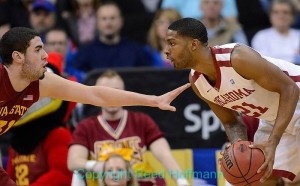
With the 2X converter on the 300, I was shooting the far end with a 600mm lens and able to get up-close and personal with the players. Nikon D4 set to white balance of PRESET1 and ISO of 8000, shutter speed of 1/1000 at f/5.6, 600mm lens. Photo copyright Reed Hoffmann.
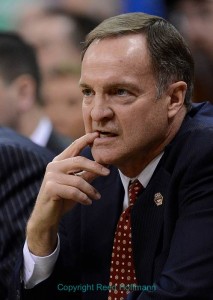
600mm also let me get much closer shots of the coaches and players watching from the bench. Nikon D4 set to white balance of PRESET1 and ISO of 8000, shutter speed of 1/1000 at f/5.6, 600mm lens. Photo copyright Reed Hoffmann.
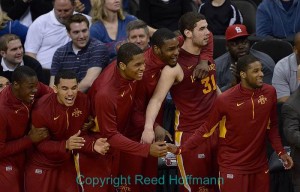
Shooting from up in the stands using a 500mm lens with the TC-14E converter gave me 700mm for these action and reaction shots. Nikon D4 set to white balance of PRESET1 and ISO of 10000, shutter speed of 1/1600 at f/5.6, 700mm. Both photos copyright Reed Hoffmann.
With that amount of telephoto, I was able to shoot much tighter action shots at the far end. The challenge was following the action, but the results were worth it. I could also make much tighter shots of the coaches and the players on the bench. I also used the TC-14E on my 500mm f/4 lens to go up into the stands. With a 700mm f/5.6 lens I could now shoot in on the action from above and still keep fairly tight framing.
Forty years ago I was shooting basketball with my Nikkormat and Kodak Tri-X film. I had to push it to 1600 ASA, and with my Nikon 105mm f/2.5 (yes, 2.5) lens wide open I could shoot at 1/125 second. It was manual focus, manual exposure, one frame at a time and fingers crossed. But the challenge then was the same it is now – make the best possible picture with the gear available. And as usual, that means putting some thought into what gear you’re going to use and how, and trying to find different ways to do that. I had fun at the Big 12, and that’s the end of the basketball season for me. On to baseball!

